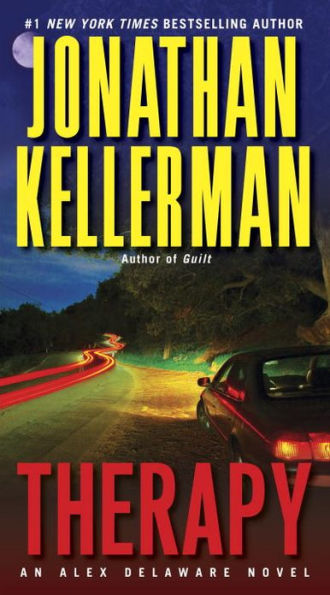Therapy (Alex Delaware Series #18)
NEW YORK TIMES BESTSELLER
Behind the yellow crime-scene tape, a brutal tableau awaits. On a lonely lovers’ lane in the hills of Los Angeles, a young couple lies murdered in a car. Each victim bears a single gunshot wound to the head. Though the female remains unidentified, her male companion has a name—Gavin Quick—and a troubled past that had landed him on a therapist’s couch.
“Labyrinthine twists, excellent pacing, and hard-boiled, swaggering dialogue.”—The Washington Post
It’s there, on familiar turf, that psychologist-sleuth Alex Delaware hopes to find vital clues. And that means going head-to-head with Dr. Mary Lou Koppel, a celebrity psychologist who fiercely guards the privacy of her clients . . . alive or dead. As Delaware follows a chain of greed, corruption, and betrayal snaking hideously through the profession he thought he knew, he’ll cross into territory even he never dreamed of treading.
1100293442
Behind the yellow crime-scene tape, a brutal tableau awaits. On a lonely lovers’ lane in the hills of Los Angeles, a young couple lies murdered in a car. Each victim bears a single gunshot wound to the head. Though the female remains unidentified, her male companion has a name—Gavin Quick—and a troubled past that had landed him on a therapist’s couch.
“Labyrinthine twists, excellent pacing, and hard-boiled, swaggering dialogue.”—The Washington Post
It’s there, on familiar turf, that psychologist-sleuth Alex Delaware hopes to find vital clues. And that means going head-to-head with Dr. Mary Lou Koppel, a celebrity psychologist who fiercely guards the privacy of her clients . . . alive or dead. As Delaware follows a chain of greed, corruption, and betrayal snaking hideously through the profession he thought he knew, he’ll cross into territory even he never dreamed of treading.
Therapy (Alex Delaware Series #18)
NEW YORK TIMES BESTSELLER
Behind the yellow crime-scene tape, a brutal tableau awaits. On a lonely lovers’ lane in the hills of Los Angeles, a young couple lies murdered in a car. Each victim bears a single gunshot wound to the head. Though the female remains unidentified, her male companion has a name—Gavin Quick—and a troubled past that had landed him on a therapist’s couch.
“Labyrinthine twists, excellent pacing, and hard-boiled, swaggering dialogue.”—The Washington Post
It’s there, on familiar turf, that psychologist-sleuth Alex Delaware hopes to find vital clues. And that means going head-to-head with Dr. Mary Lou Koppel, a celebrity psychologist who fiercely guards the privacy of her clients . . . alive or dead. As Delaware follows a chain of greed, corruption, and betrayal snaking hideously through the profession he thought he knew, he’ll cross into territory even he never dreamed of treading.
Behind the yellow crime-scene tape, a brutal tableau awaits. On a lonely lovers’ lane in the hills of Los Angeles, a young couple lies murdered in a car. Each victim bears a single gunshot wound to the head. Though the female remains unidentified, her male companion has a name—Gavin Quick—and a troubled past that had landed him on a therapist’s couch.
“Labyrinthine twists, excellent pacing, and hard-boiled, swaggering dialogue.”—The Washington Post
It’s there, on familiar turf, that psychologist-sleuth Alex Delaware hopes to find vital clues. And that means going head-to-head with Dr. Mary Lou Koppel, a celebrity psychologist who fiercely guards the privacy of her clients . . . alive or dead. As Delaware follows a chain of greed, corruption, and betrayal snaking hideously through the profession he thought he knew, he’ll cross into territory even he never dreamed of treading.
9.99
In Stock
5
1

Therapy (Alex Delaware Series #18)
528
Therapy (Alex Delaware Series #18)
528Paperback(Tall Rack Paperback)
$9.99
9.99
In Stock


Product Details
| ISBN-13: | 9780345540201 |
|---|---|
| Publisher: | Random House Publishing Group |
| Publication date: | 03/26/2013 |
| Series: | Alex Delaware Series |
| Pages: | 528 |
| Sales rank: | 152,517 |
| Product dimensions: | 4.10(w) x 7.40(h) x 1.30(d) |
About the Author
What People are Saying About This
From the B&N Reads Blog
